1. Introduction
Coffee leaf rust (Hemileia vastatrix Berk. & Broome) is considered the most important disease of the coffee (Coffea arabica L.) crop worldwide and is the cause of great economic losses (McCook & Vandermeer, 2015; Borjas-Ventura et al., 2020). The largest coffee rust epidemics were reported between 2008 and 2013 in countries ranging from Mexico to Peru, considering those years like the "rust crisis" (Cressey, 2013; Avelino et al., 2015). In 2013, the Peruvian government decreed a state of emergency for the coffee sector due to the severe rust epidemic, with losses of 60% of the harvest valued at some 290 million dollars (Julca-Otiniano et al., 2019). The San Martín region suffered significantly from the rust attack, resulting in a 50% reduction in the coffee-growing area and causing a 40% decrease in yield (Rojas-Ruiz et al., 2020).
In coffee farms, the process of H. vastatrix infection begins with the germination of uredospores on the surface of the underside of the leaves, requiring optimal conditions of humidity, temperature, and low or no light intensity (Hocking, 1968; Eskes, 1982; Haddad et al., 2009), followed by the formation of appressoria on the stomata and the propagation of the penetrating hypha in the substomatal chamber through the development of haustoria for intracellular and intercellular colonization (Ramiro et al., 2009; Gichuru et al., 2012). In the colonization process, the hyphae intertwine in the substomal cavities and form the protosori, which mature into uredos in approximately three weeks and protrude through the stomata, forming orange pustules (Talhinhas et al., 2017), these being the visible structures on the underside of the leaves.
Studies focused on determining coffee genotypes susceptible or resistant to rust and their respective degrees of severity are carried out largely in the field, taking advantage of natural conditions for the disease spread (Julca-Otiniano et al., 2019; Gutiérrez-Calle et al., 2021; Dilas-Jiménez et al., 2022), uncontrolled conditions that could influence the results. These studies also focus on determining the genetic diversity of H. vastatrix and its distribution area (Gamarra et al., 2021; Quispe-Apaza et al., 2021; Le et al., 2022; Ramírez-Camejo et al., 2022). Studies have also been reported where genotypes of interest are evaluated under greenhouse conditions using a H. vastatrix uredospore suspension obtained from infected coffee leaves of plants in field (Bustamante et al., 2001; Paredes-Espinosa et al., 2023). Currently, optimal conditions of temperature, humidity, light intensity, and photoperiod can be simulated under laboratory conditions using specialized equipment, such as phytotrons, which are climatic chambers designed for plant growth. This equipment has allowed to simulation of environmental conditions to evaluate the physiological state of coffee plants infected with H. vastatrix¸ from uredospores collected in agricultural fields (Toniutti et al., 2017). In all previous experiments, they used uredospores collected directly in the field as inoculum, conditioning these experiments to their availability in coffee farms, adding to the possible presence of natural antagonists of this pathogen. In this context, H. vastatrix uredospores are considered the primary inoculum of the coffee leaf rust cycle, and their production is fundamentally necessary for biological studies or pathogenicity tests under in situ or ex-situ conditions (Fernandes et al., 2009; Carvalho et al., 2011; Deepak et al., 2012).
There is currently limited knowledge about the ex-situ mass production methods of H. vastatrix uredospores that provide pure strain of biological material, and free pathogen antagonists to carry out bio-assays under controlled conditions on resistance and susceptibility of different coffee genotypes at any time of the year. Therefore, the objective of the present investigation was to establish an efficient protocol for the mass production of rust uredospores under controlled conditions and determine their infection in coffee seedlings var. Caturra.
2. Materials and methods
Biological material
The collection was carried out in a coffee plantation located in Chontal (S 6° 19′ 58.5″ W 76° 31′ 19.0″, 1069 m.a.s.l.), Pamashto District, Lamas Province, San Martin Region, Peru. The mean annual temperatures range from 18 to 25 °C, and 50 to 82.4% relative humidity. Coffee leaves infected with H. vastatrix and free of other pathogens was collected early in the morning, at 7:00 a.m., from a 6-year-old coffee plant var. Caturra. The infected leaves were conditioned in a cooler (≈5 °C) and immediately transferred to the “Laboratorio de Biología y Genética Molecular” (LBGM) of the Universidad Nacional de San Martín (UNSM), Tarapoto, Peru.
Viability test of Hemileia vastatrix uredospores
Infected leaves (Figure 1a) with H. vastatrix were segmented (ø = 2 cm, Figure 1b) and placed in a sterile glass jar containing sterile distilled water (100 mL, Figure 1c), then homogenized for 10 min at 600 rpm using a magnetic stirrer, to further detach the uredospores from the segmented leaf tissue. Subsequently, uredospores were quantified in a Neubauer chamber, and the concentration was 2 x 105 uredospores mL-1 (Couttolenc-Brenis et al., 2020). Uredospores viability was evaluated during different handling periods. Uredospores suspension was applied in Petri dishes (2% water-agar) at 0.0, 0.5, 1.0, 2.0, 4.0, and 5.0 hours of handling (constant agitation). Finally, plates with uredospores (for all times) were incubated at 23 ± 1 °C in total darkness for 12 hours until evaluation.
Coffee seedling production
Coffee seeds were collected by selecting mature cherries from the intermediate and proximal branches of the main stem, coming from disease-free plants. Subsequently, the cherries were decarified and washed with abundant water, removing malformed or small seeds. For pregermination, decarified seeds (≈100 g) were placed in a container with 100 mL of sterile distilled water and kept for three days at room temperature. Then the seeds were transferred to a germination litter of sterile fine river sand (Julca-Otiniano et al., 2002), placing the seeds with the central cut in contact with the sand and at 2 cm from each other. The seeds were then covered with a thin layer of sterile sand to favor germination. Constant watering was carried out for a period of 35 days, after which seedling emergence was observed on the substrate surface. Uniform seedlings at the " little soldier" stage was transplanted into black plastic pots (3 kg) with a mixture of agricultural soil and fine sand in a 2:1 ratio, respectively. Finally, the seedlings were maintained in a greenhouse with frequent irrigation, maintaining a temperature of 25 ± 1 °C and a relative humidity of 60-70%.
Massive multiplication of Hemileia vastatrix uredospores
Six-month-old coffee seedlings (5-6 pairs of leaves) were inoculated with H. vastatrix uredospores using the suspension at a concentration of 2 x 105 uredospores mL-1 (Couttolenc-Brenis et al., 2020). The inoculum suspension was sprayed on a lower surface of three pairs of leaves on each of the 20 plants (Figure 2a). After inoculation, two plastic jars (10 mL volume) containing cotton soaked with sterile distilled water were placed on the base of each plant to promote humidity (Figure 2b). A transparent polyethylene bag (width = 30 cm, length = 45 cm) was placed on each inoculated seedling, sealing the lower edge with a rubber band, creating a humid chamber for each plant, and maintaining 100% relative humidity (Figure 2c). Immediately, a black polyethylene bag (width= 35 cm, length= 50 cm) was placed over the previous transparent bag in each pot, to maintain total darkness and favor uredospore germination, in these conditions they remained for three days at a temperature of 23 ± 1 °C (Figure 2d). After this period, only the black polyethylene bag was removed and cuts were made on the upper edges of the transparent bag (1.5 cm long and 1.5 cm high, Figure 2e), to reduce the relative humidity to ≈90%, under these conditions they remained for three days with a photoperiod of 16 hours of light and 8 hours of darkness at 23 ± 1 °C.
On the seventh day, the transparent bag was carefully removed from each seedling and kept in greenhouse conditions at 23 ± 1 °C, ≈80% relative humidity, and a photoperiod of 16 light hours (1800-2000 lux) and 8 hours of darkness for 120 days (Figure 2f). At 43 days after inoculation, the incidence (infected leaves/total inoculated leaves * 100), severity (scale established by Julca-Otiniano et al., 2019) and the sporulation of H. vastatrix in coffee leaves were evaluated. Leaves with at least one pustule were collected and the infected foliar area of each one was measured. All the uredospores were removed and the total weight for each plant was registered. Sporulation was obtained as the ratio between the total weight of the rust and the accumulated infected leaf area per coffee plant (Toniutti et al., 2017).
Bioassays of inoculation with different concentra-tions of Hemileia vastatrix uredospores multiplied ex situ
From H. vastatrix uredospores that were multiplied massively under controlled conditions (as described above), a new uredospore suspension was prepared at a concentration of 2 x 105 uredospores mL-1. Different concentrations (1 µL, 2 µL, 3 µL, 4 µL, and 5 µL) of the suspension were inoculated on the lower surface of three pairs of leaves on each coffee seedling var. Caturra (n=10 plants) at six months of age. Each leaf was inoculated in two sections, divided by the midrib, with different concentrations, starting from the base area of each leaf and moving upwards (Figure 3). The inoculated seedlings were maintained under the same conditions described for the mass multiplication process of H. vastatrix.
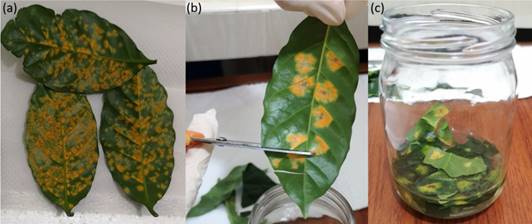
Figure 1 Isolation process of Hemileia vastatrix uredospores, (a) Coffee leaves infected with uredospores collected from the field. (b) Segmentation of leaves into fragments leaf of approximately 2 cm. (c) Conditioning of fragments of leaf in a glass bottle containing 100 mL of sterile distilled water.
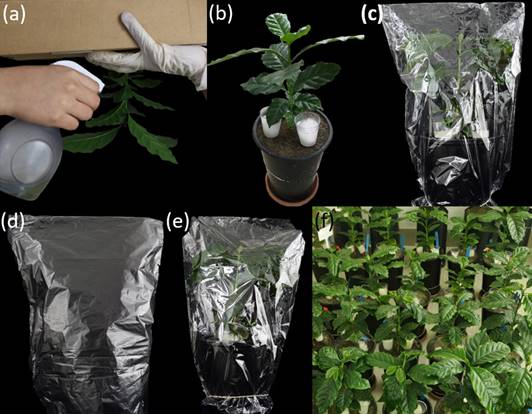
Figure 2 Ex-situ multiplication process of Hemileia vastatrix uredospore, (a) Inoculation of the coffee seedling with a suspension of uredospores (Atomizer). (b) Conditioning of 2 glasses with cotton soaked with sterile distilled water. (c) Sealing of the seedling with a transparent bag. (d) Sealing of the seedling with a black bag. (e) Cuts of the upper edges of the transparent bag. (f) Coffee seedlings conditioned in a greenhouse.
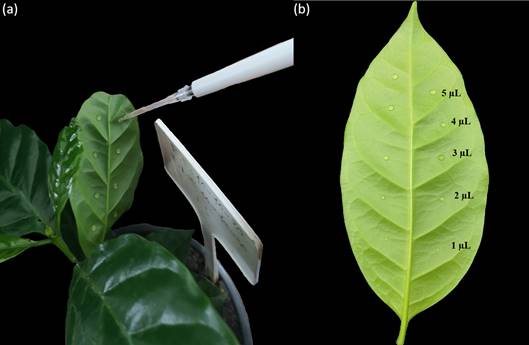
Figure 3 Inoculation of different concentrations of Hemileia vastatrix uredospores, (a) Inoculation of coffee seedling using the drip method. (b) Underside of coffee leaf inoculated with the five different concentrations.
Statistical analyses
The normality and homogeneity of all measured variables were evaluated using the Shapiro-Wilk and Levene tests, respectively. A completely randomized experimental design was performed for the viability test of H. vastatrix uredospores and for the inoculation of different concentrations of uredospores in coffee seedlings. All data obtained were subjected to analysis of variance (ANOVA) and comparison of means (Tukey, p < 0.05). In the mass multiplication of H. vastatrix uredospores, the mean of total uredospore weight (mg) and sporulation (mg cm-2) were determined. The analyses were performed in the R statistical program (version 4.1.3) (R Core Team, 2020).
3. Results and discussion
Viability test of Hemileia vastatrix uredospores
Inoculating coffee plants with H. vastatrix uredospores is a complex process because most bioassays involve the use of numerous plants (experimental units), requiring several hours of pathogen manipulation (uredospores) for each plant's inoculation. Therefore, it was necessary to assess the viability of H. vastatrix uredospores during different handling times.
The inoculation process of coffee plants with a suspension of H. vastatrix uredospores in different periods of handling (hours) presented a germination range between 39 - 55%, observing decreasing viability of the uredospores as a function of the time (Figure 4). The viability of the uredospores in time periods of 0.0, 0.5 and 1.0 hours did not show significant differences, obtaining 55.2%, 54.9% and 54.1% germination, respectively. After 2 hours, the viability of the uredospores was significantly reduced, reaching 50% germination, and decreasing to 39.3% germination at 5 hours.
A decrease in the percentage of germination of H. vastatrix uredospores is observed, as the handling time increases (Figure 4). This is probably due to the constant agitation that could have affected uredospore germination related to damage in the cell walls by friction (Urrego et al., 2008). The loss of viability could also be a consequence of the imbibition of the uredospores for prolonged times in a suspension of sterile distilled water, reducing their oxygenation; likewise, this excess of water would favor a hypotonic environment for the cells, leading to the rupture of the uredospores walls (Nutman & Roberts, 1963). In addition to the fact that the uredospores were suspended in a medium (sterile distilled water) that does not provide the conditions required for them to remain viable for a long time. In this regard, Deepak et al. (2012), mention that H. vastatrix, as a biotrophic fungus, cannot survive for a long time without a living source, such as the coffee leaf, in this way any free uredospore that cannot reach a coffee leaf will die in a short time.
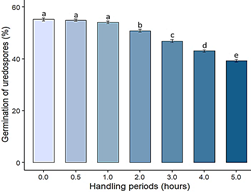
Figure 4 Percentages of Hemileia vastatrix uredospores germination in different periods of handling time under constant agitation (600 rpm). Means with the same label do not differ statistically (p < 0.05).
The highest percentage of uredospore germination of H. vastatrix was obtained at time 0.0 reaching 55%. Close results were obtained by Toniutti et al. (2017), who evaluated inoculum from different origins and obtained more than 50% germination. Similarly, Morales-Antonio et al. (2021), only obtained up to 16% germination of field-collected uredospores. In both cases, the authors did not report the time the uredospores were kept in suspension before evaluating their germination, and this could be one of the factors that could have influenced the viability of H. vastatrix uredospores, specifically in the second study. On the other hand, in our experiment, we evaluated the germination at 12 hours. In this regard, Nutman and Roberts (1963), as well as Diniz et al. (2012) suggest that the maximum germination time of uredospores occurs 2-3 hours after they attain the required conditions and stops after 8-12 hours. Similarly, de Jong et al. (1987) reported a maximum germination time between 12 and 24 hours, with no significant difference between them.
The germination of H. vastatrix uredospores requires various factors under in vitro conditions, among the main ones being temperature. Diniz et al. (2012), mentioned that uredospores require temperatures ranging from 18 to 24 °C for optimal germination, temperatures above or below this range drastically affect the germination. In our study, we obtained germination percentages of H. vastatrix uredospores greater than 50% at a temperature of 23 ± 1 °C, being within the optimal temperature range. Similarly, Toniutti et al. (2017), obtained germination percentages higher than 50% also using a temperature of 23 ± 1 °C.
The absence of light is another of the main factors required for the successful germination of H. vastatrix uredospores under in vitro conditions (Nutman & Roberts, 1963; Hocking, 1968), results that were confirmed with our study. Likewise, Morales-Antonio et al. (2021), reported that at low light intensity, the uredospores also manage to germinate, but in a very low percentage.
Massive multiplication of Hemileia vastatrix uredospores
This study allowed a massive multiplication of H. vastatrix uredospores, reaching 100% incidence of coffee plants with 44% disease severity in leaves (Figure 5). The first signs of H. vastatrix infection were observed in coffee leaves on day 20 after inoculation. Then, 43 days after inoculation, an average of 54 ± 4.8 mg of uredospores per plant were obtained, with sporulation of 1.38 x 10-1 ± 0.12 x 10-1 mg/cm2 of infected leaf area. Infection caused necrosis and leaf drop (detachment) of 33% of infected leaves/plant at 120 days.
The germination of H. vastatrix uredospores is the critical point in the infection process in coffee leaves. Therefore, it is necessary to have optimal conditions of temperature, humidity, and light intensity that will allow the pathogen to penetrate and colonize the coffee leaf tissue (Haddad et al., 2009). In the present study, we induced the germination of H. vastatrix uredospores using a temperature of 23±1 °C, similar to that used by Toniutti et al. (2017); which is in the range of optimal values (22 to 24° C) established by de Jong et al. (1987) and Rozo et al. (2012). It has been proposed that temperature and humidity are of essential components in the critical period of uredospore germination and their subsequent penetration into the leaf through the stomata. The pathogen depends largely on the temperature of the leaf surface, as well as the humidity of the environment (Bebber et al. 2016). Likewise, in our greenhouse, total darkness during the first three days after inoculation was also fundamental in the germination and colonization process. Under controlled conditions using a phytotron, Toniutti et al. (2017) also demonstrated that the absence of light is mandatory to initiate uredospore germination. In this sense, our study used 100% relative humidity during the first three days, later it was reduced to ≈90% during the following three days and from the seventh day it was adjusted to ≈80% until the end of the experiment (120 days). Conversely, Toniutti et al. (2017), maintained a constant humidity of 100% during the entire rust infection process. The sequential decrease of relative humidity in our study was achieved by cutting the tips of the bags starting on the third day (≈90%) and subsequently removing the same bags on the seventh day (≈80%). This methodology is supported by unpublished data that showed plasmolysis-related leaf wilting in plants that were exposed to 100% humidity for more than seven days (plants covered with transparent bags).
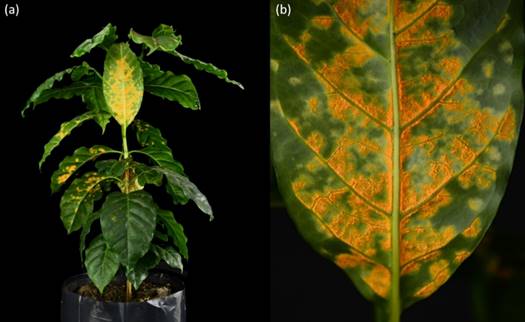
Figure 5 Ex-situ multiplication of Hemileia vastatrix urediospores, (a) Coffee plant 43 days after inoculation with H. vastatrix urediospores under controlled conditions. (b) Coffee leaf with severe H. vastatrix infection in controlled conditions.
In our study, the first visual symptom (orange pustules) was observed on coffee leaves 20 days after inoculation. This result is consistent with the findings of Toniutti et al. (2017), who determined a latency period of 21 days for uredospores until the appearance of the first leaf spots on coffee var. Caturra leaves. Furthermore, Kushalappa (1989) and Leguizamón-Caycedo et al. (1998) mentioned that the sporulation time of the rust in susceptible coffee leaves starts on day 15 after infection under field conditions.
An average of 54 mg of H. vastatrix uredospores per plant and sporulation of 1.38 x 10-1 mg/cm2 per infected leaf area was obtained 43 days after inoculation, using an innovative protocol under a traditional greenhouse. These results showed better performance compared to those of Toniutti et al. (2017), who obtained 1.2 x 10-1 mg/cm2 of sporulation per infected leaf area in Caturra coffee variety 43 days after inoculation, using a phytotron.
Our innovative and practical methodology will allow us to have abundant biological material at any time of the year using a greenhouse (closed environment with air conditioning) and easily acquired materials, without the need for a climatic chamber (phytotron) that requires a high investment cost. Moreover, the developed methodology will allow bioassays to determine coffee genotypes resistant to coffee leaf rust in breeding programs.
Bioassays of inoculation with different concentrations of Hemileia vastatrix uredospores multiplied ex-situ
The application of different concentrations of uredospores on the underside of coffee leaves showed no significant differences (except the concentration of 1 µL) in the germination of H. vastatrix uredospores and the development of pustules (Figure 6). Our results showed that with a concentration of 2 x 105 uredospores mL-1, the application of 2 µL was efficient for the formation of pustules, presenting no significant differences with respect to the application of 3, 4, and 5 µL.
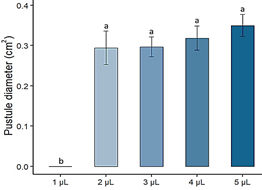
Figure 6 Pustule formation upon inoculation of droplets with different concentrations of Hemileia vastatrix urediospores. Means with the same label do not differ statistically (p < 0.05).
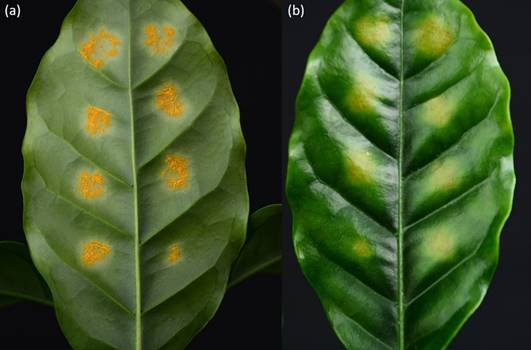
Figure 7 Inoculation of drops with different concentrations of Hemileia vastatrix urediospores multiplied ex-situ, (a) Formation of pustules on the underside of coffee leaves from a concentration of 2 µL. (b) Chlorosis on the upper side of coffee leaves is a symptom of H. vastatrix infection.
However, it was observed that the application of 1 µL did not contain a sufficient amount of uredospores for the formation of pustules within the evaluated period of 43 days (Figure 7). Likewise, pustule development was observed on all leaves inoculated with 2-5 µL uredospore droplets (100% incidence).
The application of drops with suspension of H. vastatrix uredospores to leaves, is a methodology used in most reports to determine resistance or susceptibility of coffee genotypes to rust (Capucho et al., 2009; Rozo-Peña & Cristancho-Ardila, 2010). This methodology also allowed conduct studies on the identification of different coffee rust strains (types) (Álvarez-Lemun & Alvarado-Alvarado, 2001; Cabral et al., 2009).
Concentrations of 2 µL (400 uredospores) of the H. vastatrix uredospore suspension applied to coffee leaves allowed the germination and development of pustules in all inoculated leaves (100%), with no significant differences between concentrations 2-5 µL. In this regard, Rozo-Peña & Cristancho-Ardila (2010), who used drops containing 5 µL of a suspension of uredospores (0.5 mg mL-1) obtained 100% of leaves with chlorotic spots (var. Caturra). Likewise, Álvarez-Lemun & Alvarado-Alvarado (2001), used the same method of dripping with concentrations of 10 µL (750 uredospores) of a suspension of uredospores (75 x 103 uredospores mL-1) and obtained 94% formation of lesions in leaves of coffee. Our results showed that it is not necessary to apply high concentrations to obtain chlorotic spots produced by the sporulation of H. vastatrix.
The methodology using drops from a suspension of uredospores was also applied for bioassays with individual leaves (detached from the plant) collected in the field or nursery to determine resistant and susceptible coffee genotypes (Cabral et al., 2009). The use of individual coffee leaves minimizes the workspace and does not require much care compared to working with the whole plant, allowing experimentation with a greater number of genotypes in a smaller work area.
4. Conclusions
An efficient and practical protocol was established for the mass production of coffee rust uredospores under controlled greenhouse conditions, with an average production of 54 mg of H. vastatrix uredospores per plant, 43 days after inoculation. Likewise, bioassays allowed us to determine the pathogenic efficiency of these uredospores produced ex-situ. Through this protocol, it is possible to have and use biological material throughout the year and continue with research to determine resistant coffee genotypes, as well as plant-pathogen interaction studies.















